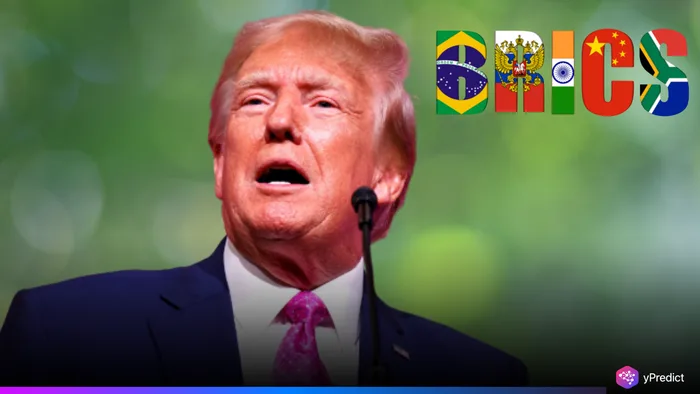
Ex-President Donald Trump has ramped up geopolitical and economic tensions with his warning to BRICS markets that he will impose a 10% tariff should they undermine the U.S. dollar. These comments come at a time of increasing action by BRICS (Brazil, Russia, India, China, and South Africa) to staunchly reduced dollar reliance for their trade. Trump’s comments reiterate a larger strategy of effectively employing trade weapons to retain financial control for the U.S.
This BRICS tariff warning signals not just an economic shift but a global power struggle. As countries in the Global South seek more autonomy, Trump is drawing red lines around dollar dominance. The former president, known for his America First doctrine, appears ready to revive a confrontational trade policy if re-elected, with monetary supremacy at the center of it all.
Why Trump Sees BRICS as a Threat to the Dollar
The BRICS group has become more vocal in calling for the de-dollarization of global commerce and in the latest summits, brought forth various other pathways they could take with regard to alternate settlement systems and regional currencies to avoid the use of the dollar. Each of these moves is a direct affront to the U.S. financial system, which rests on the ubiquitous use of its currency in international transactions.
Trump’s warning of a BRICS tariff signifies his general concern that id BRICS can bring this project to fruition, there could be significant loss of power from the United States. A de-dollarized world will dismantle U.S. powers of sanctions and management of global liquidity. For Trump and many within the institutional arrangements predicated on dollar supremacy, dollar dominance remains an important tool for geopolitical leverage and not simply an economic necessity.
How the Tariff Threat Fits Trump’s Trade Doctrine
The 10% tariff threat fits neatly into Trump’s existing playbook. During his presidency, he imposed sweeping tariffs on China, the EU, and North American trade partners. This latest move extends his doctrine to a larger bloc of nations working against American monetary dominance.
Trump’s BRICS tariff warning isn’t just a hypothetical. It’s a message to global markets and U.S. allies that a second Trump administration would defend the dollar through direct economic retaliation. For him, trade is war, and currency is ammunition.
Global Reactions to the BRICS Tariff Warning
Reactions to Trump’s remark were immediate and split. Some Western economists believe that the BRICS nations are bluffing and have no alternative to the dollar. Alternately, they believe that the warning is just a move to delay the inevitable diversification of the global finance system: that no longer centered on the dollar system.
BRICS leaders, especially from China and Russia, are continuing to push for an alternative financial system, arguing that U.S. control of SWIFT or dollar clearing, etc., are now or at least, made sense as of today. Trump’s move may hasten their rationale to step up their effort, or find reasons to ask other more moderate countries to take a side as an economic divide accelerates.
What It Means for the Future of Global Trade
The BRICS tariff warning could reshape future U.S. trade policy. It signals that economic nationalism and hardline tariff strategies are back on the table. Trump isn’t just defending factories or jobs, he’s defending the currency itself.
If this warning materializes into real policy, it could trigger tit-for-tat measures from BRICS nations. That would fracture global trade flows and risk inflation spikes. Countries trying to stay neutral might face pressure to either side with the U.S. and its dollar or pivot toward BRICS-aligned systems.
Can the U.S. Realistically Stop Dollar Alternatives?
Despite the rhetoric, experts question whether tariffs can truly halt the global trend toward de-dollarization. The dollar remains dominant, but momentum is slowly shifting. Energy deals between Russia and China, and the growing role of the yuan in African trade, show signs of a gradual transition.
Trump’s BRICS tariff warning may slow the process but likely cannot stop it. Analysts argue that global trust in the U.S. financial system has eroded since the weaponization of sanctions. The world wants options, and BRICS is trying to build them.
Final Thoughts on Trump’s Strategic Gamble
Trump’s strategy marks a pivotal moment in global economic policy. His warning to BRICS blends trade tools with geopolitical power plays. Whether it works depends on how seriously other nations take his threat, and how united BRICS becomes in pushing for change.
Rather than fostering cooperation, the BRICS tariff warning could widen the global economic divide. Still, for Trump and his supporters, defending the dollar is worth the risk of trade confrontation. The battle for monetary control may define the next phase of international politics.







